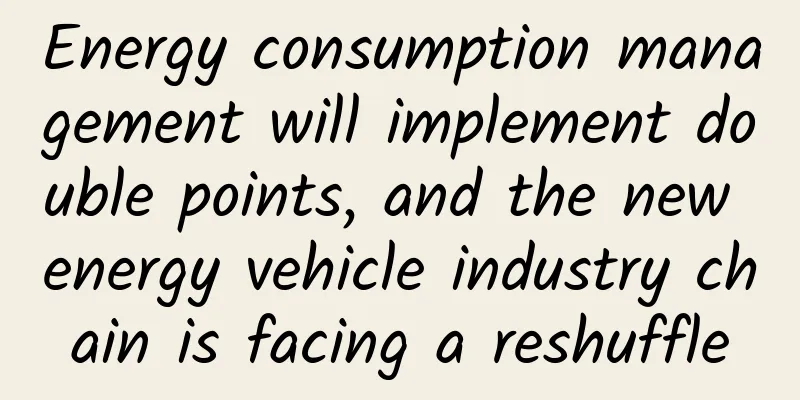Energy consumption management will implement double points, and the new energy vehicle industry chain is facing a reshuffle

|
A relevant person in charge of JAC Motors said in an interview with a reporter from China Securities Journal recently that the new dual-points management policy is in line with the company's development direction and will maintain the existing strategic goal of new energy vehicles as the company's strategic core business segment. The Ministry of Industry and Information Technology recently released the "Measures for the Parallel Management of Passenger Car Enterprises' Average Fuel Consumption and New Energy Vehicle Credits (Draft for Comments)" (hereinafter referred to as the "Draft for Comments"), which clearly stipulates that the dual credits will be managed in parallel for car companies, and the evaluation system will be tilted towards low-energy consumption and high-efficiency passenger car models. Industry insiders believe that according to the Draft for Comments, car companies with a high proportion of new energy vehicle production in the company's total production will gain a greater advantage, and models with high mileage, low power consumption and lightweight body will benefit. Points can be carried forward for transactions According to the draft for comments, passenger car companies will be evaluated based on the average fuel consumption points of passenger cars and the proportion points of new energy vehicles. Among them, the fuel consumption points of traditional passenger cars will still be implemented according to the relevant ratios specified in the "Passenger Car Fuel Consumption Evaluation Method and Indicators" (hereinafter referred to as "Evaluation Method and Indicators") implemented on January 1, 2016. According to the evaluation method and indicators, from 2018 to 2020, the fuel consumption targets for passenger cars per 100 kilometers must reach 6.0L, 5.5L and 5.0L respectively; and the proportion of new energy vehicle points of passenger car companies must reach 8%, 10% and 12% from 2018 to 2020. The draft for comments clearly stipulates that positive points for new energy vehicles can be used to offset the same number of negative points for average fuel consumption. In addition, positive points for new energy vehicles can be freely traded among passenger car companies. Passenger car companies with negative average fuel consumption can use the positive points for average fuel consumption carried forward by the company, the positive points for new energy vehicles generated by the company, the positive points for average fuel consumption transferred, and the positive points for new energy vehicles purchased from other companies to offset and return to zero. At the same time, the draft for comments proposes that for passenger car companies that have not compensated for negative points for new energy vehicles in accordance with this method, the production or import of some traditional energy passenger car models should be suspended until the production or import volume of traditional energy passenger cars in that year decreases by no less than the number of uncompensated negative points compared with the previous year. Some analysts believe that compared with the September 2016 version of the Interim Measures for the Parallel Management of Enterprise Average Fuel Consumption and New Energy Vehicle Credits, the new version of the policy name has removed the word "interim", which means that the policy will become a long-term established policy after implementation. At the same time, the new draft for soliciting opinions on the points system has changed from the previous simple mileage corresponding points to a calculation formula; new energy vehicles will introduce power consumption indicators based on vehicle weight, and the lower the power consumption, the higher the points multiplier. Automakers have different expectations Under the new dual-point management policy, listed companies are "some are happy and some are sad", and the new energy vehicle industry chain may change. According to the draft for comments, automakers with a high proportion of new energy vehicle production in their total production will have a greater advantage. Take JAC Motors as an example. As the company's core strategic business segment, new energy vehicles are the company's mid-term goal to achieve a sales volume of new energy vehicles accounting for 20% of the total by 2020. iEV4 and iEV5 are the main pure electric models currently on sale by JAC Motors, and iEV6 and iEV7 are expected to be launched in 2017. The company's recent production and sales announcement shows that in 2016, the company sold a total of 18,400 pure electric passenger cars, a year-on-year increase of 74.59%. According to CITIC Securities' calculations, JAC's pure electric vehicle sales target for 2017 is 27,000 units. Based on an annual growth rate of 30%, its pure electric vehicle sales target for 2018 is 35,000 units. Based on an average of 3 points per vehicle, JAC can obtain 105,000 points in 2018. JAC Motors' production in 2018 is expected to be about 400,000 units. To meet the 8% points requirement, a total of 32,000 points are required, and its surplus points can reach more than 70,000 points. The transaction will provide a guarantee for the company's profitability. A relevant person in charge of JAC Motors told a reporter from China Securities Journal that the new dual-credit management policy is consistent with JAC's own pure electric technology route, and JAC will maintain its existing strategic goals. At present, the market structure based on the credit background is far from mature, and the state and enterprises should work together to promote the expansion of the new energy vehicle pie. "It is expected that the market structure will be initially determined when the annual production and sales volume reaches millions of vehicles." According to the draft for comments, with the mass production of new energy vehicles, it is imperative for traditional car manufacturers to improve the fuel consumption efficiency of their entire vehicles. Take Great Wall Motors as an example. The company is still relying on high-fuel-consumption SUV models to "walk on one leg". Without the support of new energy models, Great Wall Motors is undoubtedly bearing heavy fuel consumption pressure. If its product line is not adjusted, a large number of negative new energy points will be generated in the future. According to Great Wall Motors' current product planning, it has placed a large number of new energy points on the newly launched WEY brand. However, it is unknown whether the engine and vehicle fuel consumption efficiency of the WEY brand can save the Haval brand. Changan Automobile, the leading domestic brand, is also under great pressure in terms of fuel consumption. Changan Automobile's new energy sector started late, and compared with the huge volume of traditional fuel vehicles, its fuel consumption points and new energy points face dual challenges. Multiple sub-sectors will benefit The new dual-credit management policy is a great challenge to all automobile companies. As the credit requirements for new energy vehicles increase year by year, the number of new energy passenger vehicles expected to be promoted from 2018 to 2020 is expected to be 780,000, 900,000 and 1.02 million respectively. Some automotive industry analysts bluntly stated that the government should introduce supporting policies for multi-city restrictions on driving and purchase as soon as possible, so as to release more license plate dividends and increase the promotion of the new energy vehicle market. Industry insiders believe that under the new policy, companies that have made early arrangements for new energy vehicles are expected to benefit. According to the draft for comments, automakers with a high proportion of new energy vehicle production in their total production will have a greater advantage. At the current stage, domestic automakers will benefit due to the high proportion of new energy passenger vehicles, while joint venture automakers will face certain pressure. At the same time, since the new double-point management policy has put forward requirements for the energy density and driving range of automobiles, high-energy-density batteries will be the direction of future automotive power batteries, and the ternary lithium battery industry chain represented by this will continue to benefit. In addition, under the background of increasingly stringent review of various indicators, the development of the battery industry will lead to the birth of industry giants, which will help leading targets with core technologies to continue to expand their market share. Essence Securities believes that, in the case that the energy density of power lithium batteries is difficult to increase significantly in a short period of time, lightweighting of the vehicle body has become an important option for extending the range of new energy vehicles. Essence Securities estimates that by 2020, the market size of composite materials used in lightweighting of vehicles will reach 10 billion yuan. Benefiting from the increasing pressure of fuel consumption restrictions on OEMs, related companies with fuel-saving technologies in the industry chain will benefit. Take Camel Co., Ltd. as an example. As a leader in automotive starter batteries, Camel Co., Ltd. has long benefited from the increase in the start-stop system installation rate under the pressure of fuel consumption restrictions on passenger cars. At present, the installation rate of start-stop systems in passenger cars in my country is about 5%, and it is expected that this figure will increase to about 50% by 2020. A relevant person in charge of Camel Co., Ltd. told a reporter from China Securities Journal that the company's diversified system upgrades and renovations will enable more new energy vehicle models to be equipped with start-stop systems. As a winner of Toutiao's Qingyun Plan and Baijiahao's Bai+ Plan, the 2019 Baidu Digital Author of the Year, the Baijiahao's Most Popular Author in the Technology Field, the 2019 Sogou Technology and Culture Author, and the 2021 Baijiahao Quarterly Influential Creator, he has won many awards, including the 2013 Sohu Best Industry Media Person, the 2015 China New Media Entrepreneurship Competition Beijing Third Place, the 2015 Guangmang Experience Award, the 2015 China New Media Entrepreneurship Competition Finals Third Place, and the 2018 Baidu Dynamic Annual Powerful Celebrity. |
>>: MWC2017 is coming soon: Why Nokia refused to use Android
Recommend
Decoding Nokia vs. Apple: In the patent duel, who is the rogue? Who is the gangster?
The second round of patent war between Nokia and ...
Logic analysis of product selection in live broadcast rooms
Regarding live streaming sales , my view has alwa...
Two marketing warnings during the epidemic
After the outbreak of the new coronavirus pneumon...
Even light can be frozen! What is the concept of "absolute zero" of -273.15 degrees?
What is temperature? You might think, isn't t...
Some notes created on iOS 15 and macOS Monterey are not available on older versions of the operating system
[[409492]] According to foreign media 9to5Mac on ...
Quantitative Learning Cloud Lecture Hall Wang Yan's Four-dimensional Three-first Selection and Following the Banker Basic Training Class 30th
: : : : : : : : : : : : : : : : : : : : : : : : : ...
How much does it cost to create a prenatal education app in Xiangfan?
How much is the price for producing the Xiangfan ...
Why can’t you come up with a case that will go viral on WeChat Moments?
Yesterday, NetEase Cloud Music ’s “Your Jungian P...
The click-through rate increased by 45% in 2 days, and the conversion rate exceeded 90%. Information flow optimization creativity needs to do these 4 things right!
“Every time I write a creative idea, I feel so pa...
How does a large company headquarters manage the company’s entire WeChat public account?
In recent years, the heads of new media communica...
I never thought that eating eggs this way is more nutritious!
When I was a kid, I had to eat two boiled eggs ev...
Samsung S7 sales in the US outstripped Apple 6S? US media: There is no point in comparing
According to foreign media reports, according to ...
Lemon Class-Test Management Team Leader Manager President Class
Lemon Class - Test Management Team Leader Manager ...
Is the “one-letter difference” between aviation and aerospace a “thin line of separation”?
Are aviation and aerospace the same thing? This i...
Bidding promotion: a universal method to improve bidding conversion rate!
There are many bidding issues, but in my opinion,...









